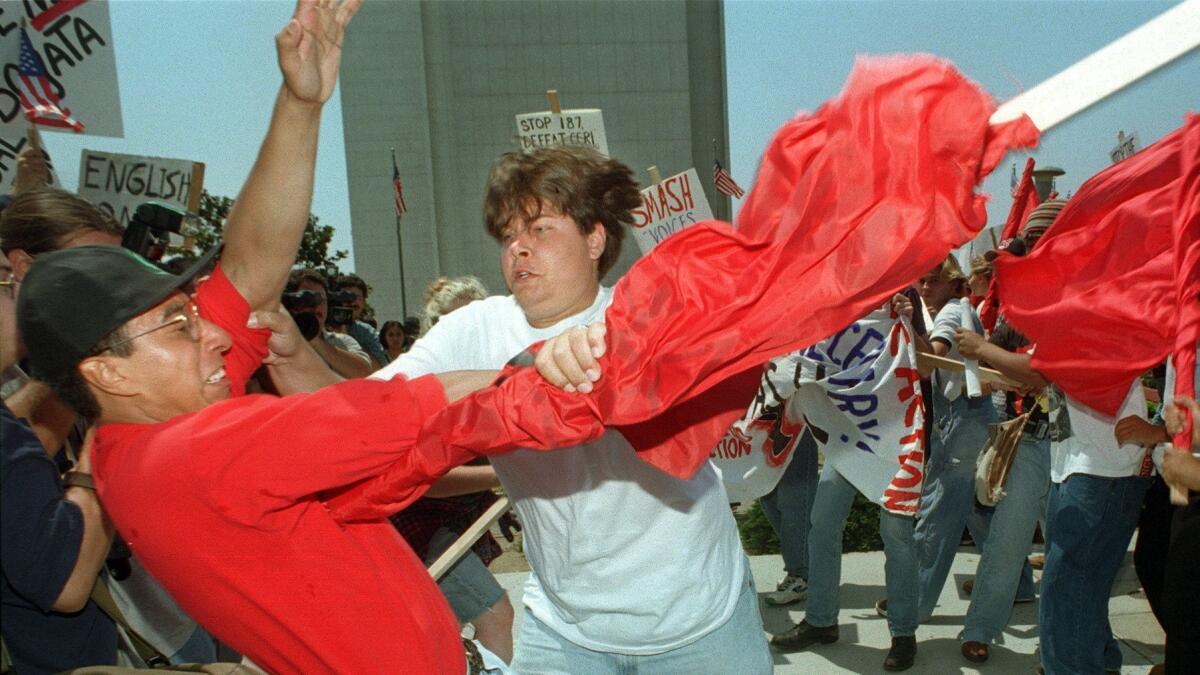Op-Ed: California used to be as anti-immigrant as Trump. Don’t repeat our mistakes

- Share via
Last week, when the Trump administration sued California over its so-called sanctuary laws, Gov. Jerry Brown and Atty. Gen. Xavier Beccera made it clear that Sacramento would resist any effort to force the state to take on federal immigration enforcement responsibilities. Instead they would do all they could to protect families, communities and business from the disruptions caused by deportations.
From immigrant rights to climate policy to minimum wage to making it easier to vote, the state functions as the epicenter of progressive opposition to Washington. Indeed, California Assembly Speaker Anthony Rendon and Senate President Pro Tem Kevin de León greeted (or perhaps, bemoaned) the election of Donald Trump with a next day statement declaring that the state would “not be dragged into the past. We will lead the resistance to any effort that would shred our social fabric . . .”
This radical embrace of inclusion stands in contrast to the Golden State’s less-than-generous past.
California foreshadowed the nation’s current anti-immigrant turmoil in 1994, with Proposition 187, a ballot measure intended to strip public services from anyone in the state illegally. Demographic anxiety and economic fear bubbled beneath the restrictionist measure: The decline in good-paying manufacturing jobs in the state between 1990 and 1994 was nearly the same as the decline in (now Trump-sympathetic) Michigan between 2007 and 2011.
Even as the economy was sinking, one business model was on the rise: profiteering from political polarization. Local talk radio fanned the anti-immigrant (and anti-tax) flames in Los Angeles in the 1990s. Thousands of immigrant marchers protested 187, some carrying flags of Mexico, El Salvador and other Latin American countries. The middle ground crumbled.
California has been through the anxious, mean-spirited and divisive rhetoric and policy-making now gripping Washington.
California likely had to pass — and come to regret — Proposition 187 before the state’s reactionary paroxysm could end. The measure’s draconian policies, caught up in court battles, never went into effect. But the bruising debate it generated wore on, until social and economic realities began to make it clear that dividing the population by race and nativity was doing more to extend the state’s problems rather than solve them.
First, demographic change slowed and the shock of it waned. California had received roughly half of the nation’s immigrants through the 1970s and 1980s, but the share of state residents who are foreign-born has been more or less stable since 2000. As immigrants settled in, more Californians came to see them as neighbors rather than interlopers. Many immigrants naturalized, adding voters to the electorate who were sympathetic to the plight of newcomers. And the U.S.-born children of immigrants stuck to the state: About 60% of whites between the ages of 25 to 45 who were born in California still live in California, but that figure is 80% and 82% for Latinos and Asians in the same age group.
Second, California reformed old political rules. Term limits were viewed by conservatives as a way to reduce the power of incumbent Democrats, but forcing older politicians out of office also paved the way for the rise of firebrands like de León, who cut his political teeth organizing against Proposition 187. Meanwhile, a push for citizen- rather than party-led redistricting did what it was supposed to do: produce more winners who are in line with the majority in the state, two-thirds of whom now support protections for immigrants and disapprove of President Trump’s performance in office.
The state’s civic engagement quotient also rose. New labor unions emerged to fight for worker benefits; minority groups advocated for shifts in policing; and environmental justice groups insisted that reducing air pollution in low-income communities was just as important as reducing greenhouse gas emissions. As many of these groups went from protest to power, their votes helped make it easier to raise state taxes, to pass sentencing reforms (and shrink the prison population), and to steer education resources to students with the most need.
Finally, the state’s economic and business calculus shifted. The ways low- and high-skilled immigrant labor could help lift most boats was proved academically and in people’s lives. The loss of manufacturing hit Southern California hard, but Silicon Valley’s rise began to fill the gaps. It also moved business dynamism northward, toward the historically more liberal Bay Area. The tech sector has proved suspicious of unions, but it is open to immigrants, to diversity (at least in theory), and even to government interventions to promote greener industries.
The state remains challenged by big issues. These include a stinging housing crisis, embarrassing income inequality and continuing criminalization of black and Latino youth. But California has ranked in the top 10 for job growth in the last two years; more than half of the nation’s venture capital gets invested in California; and the state boasts the world’s sixth-largest economy.
California has been through the anxious, mean-spirited and divisive rhetoric and policy-making now gripping Washington. We’re here to say that there’s no need to repeat our mistakes. Building bridges rather than walls has paid off: California is a state of resistance, but it’s also a state of resilience, and the nation would do well to take notice.
Manuel Pastor, a sociology professor at USC, is author of the forthcoming “State of Resistance: What California’s Dizzying Descent and Remarkable Resurgence Mean for America’s Future.”
Follow the Opinion section on Twitter @latimesopinionand Facebook
More to Read
A cure for the common opinion
Get thought-provoking perspectives with our weekly newsletter.
You may occasionally receive promotional content from the Los Angeles Times.










